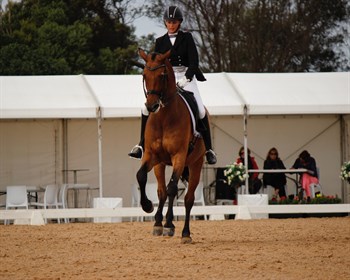
Kylie Riddell and Clive in the canter.
© EQ Life
Flying Changes - Part II
By Dr Kerry Mack
Last blog we started to talk about the flying changes, and how to introduce them in a friendly way to a green horse, before the horse is really ready to train them. So this blog let's talk about actually training the changes, bearing in mind some principles apply.
Always start by changing onto the supple side, for most horses this will be right to left. Train one side at a time, e.g. flying change right to left, simple change left to right, flying change left to right. This is easier for him as he does not have so many nerve fibres communicating across from the left half, to the right half of his brain (and vice versa) so the change right to left is a different exercise, in his experience, than the change left to right. Remember - it is always best to train one thing at a time!
- Always train changes in a friendly way. He must think the changes are the easiest thing in the world, so must not get tense or anxious about them or be afraid that if he makes a mistake he will be reprimanded. Don't pump up the adrenaline at this moment and take time.
- Always reward any attempt to start with. If you get a good change when you are starting reward immediately. Walk or get off and finish the lesson. Don't be greedy. Take time. Do it again tomorrow.
- If you strike a problem go back a step. Remember that the most common problem with the changes is poor riding, either in giving the aid or in structuring the lesson so he doesn't understand. Nearly all horses change easily and cleanly without a rider. Be friendly and take time!
You will know that before you start to train the changes there are some prerequisites. Counter canter must be established. You should be able to lengthen and shorten the stride a bit within the counter canter. He must really understand the aid for a transition into canter. I prefer to train the canter transition mainly from my inside leg. Too much outside leg tends to lead to crookedness in the changes in my view. Later on the outside leg is being used to move the quarters sideways, which you don't want in the changes.
Right from breaking-in we teach inside leg on the girth means canter. We do lots of repetitions. Inside leg. Canter. No running. Of course lots of people use outside leg as their primary canter aid and do it well. This is just my own personal preference. There is rarely one right way to do anything, and I worry about anyone who is really dogmatic that their way is the right way about anything.
So if you are planning to start the changes warm him up in the usual way. Test the responses you need. Canter transitions from walk each way. Counter canter, but don't do too much. Do some walk to counter canter transitions, or simple changes to counter canter. I then like to do some counter canter on a big circle and get him used to changing the bend. Counter canter with right canter on a left circle and ask him to bend his nose to the inside. No change. He must let you bend him around the new inside leg. No change. No pressure. I do not train the changes until this exercise is established. Making sure he understands this helps to ensure that he changes on the leg aid and not on the preparation. This becomes very important when doing tempi changes and you are counting strides. He must change on the stride you ask him, not anticipate the change and do it when you change the bend. When you get to two and one tempi changes you don't have time to change the bend. Changes must be straight, which is another reason he mustn't learn to change off the rein. If you take time to have it right at the beginning you will find the progression to the more difficult work will go much more smoothly.
And now you will have to wait until next week for my favourite flying change exercises. That is what training changes is about. Make sure the preparation is right and take time. Be patient!
'Til next time have fun!
Kerry
READ THE LATEST NEWS ARTICLES HERE
https://www.equestrianlife.com.au/articles/Flying-Changes-Part-II
